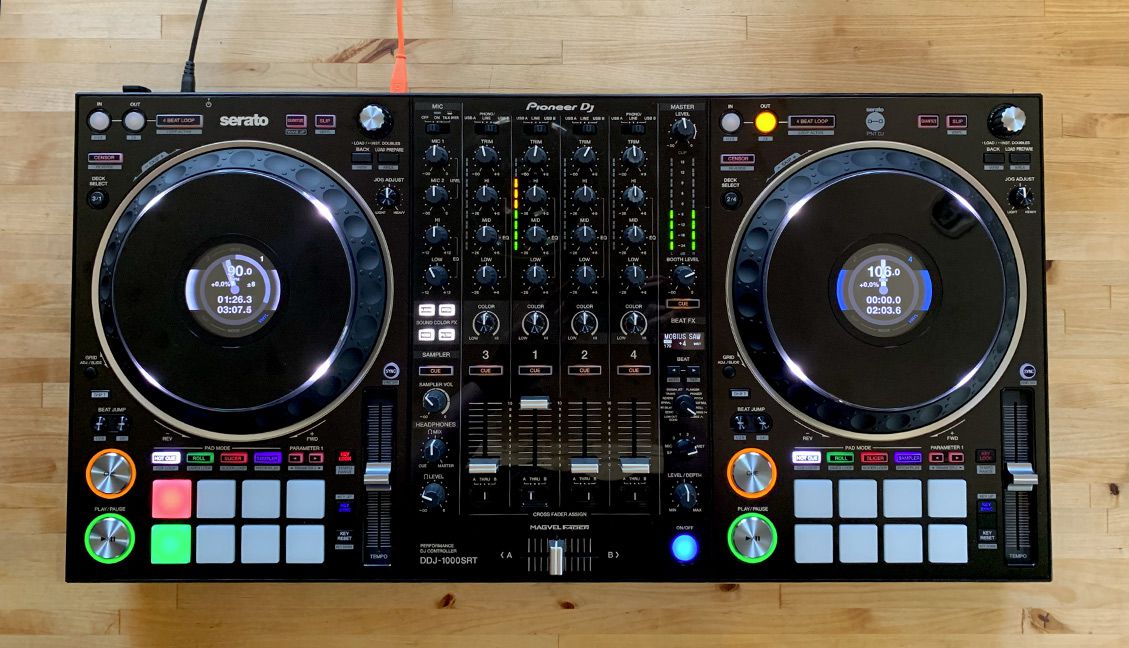News
Review: Pioneer DJ’s DDJ-1000SRT Controller brings NXS2-style control to Serato DJ
Serato users seeking a club-standard experience have reason to turn up this week. Pioneer DJ just announced the 4-deck DDJ-1000SRT, a high-end, all-in-one controller that adapts the Rekordbox DDJ-1000 for Serato DJ Pro. The DDJ-1000SRT bases its 4-channel layout directly off the DJM-900NXS2 and CDJ-2000NXS2. Contributing writer Markkus Rovito takes one of the world’s first looks at this gem.
- Reviewed: Pioneer DDJ-1000SRT Controller for Serato DJ Pro
- Price: $1,299
- Available: Preorders available in the DJTT store, release date very soon
- Ships with: Serato DJ Pro software, Pitch ’n Time DJ expansion, AC adapter, USB cable
- Size + Weight: 27.9 x 14.2 x 2.9 inches, 13.2 lbs
- Connections:
- 4 RCA stereo inputs: 2 with Phono/Line switching
- 2 Mic inputs: 1 XLR/1/4” combo input; 1 1/4” input
- 3 monitor outputs: 1 XLR Master out; 1 RCA Master out; 1 1/4” Booth out w/separate level control
- 2 headphone outputs: 1 1/4” jack; 1 1/8” jack
- 2 USB Type B ports
- Compatibility: Serato Flip, Serato DJ DVS, Serato Video, Serato Play, Serato Studio (coming soon)
NXS2 Style for Serato
This new DDJ-1000SRT basically mimics the previous DDJ-1000 for Rekordbox DJ, except that it’s now a Serato DJ Pro controller with support for all the expansions like Serato Flip and DVS. The unit includes the use of Serato DJ Pro and the Pitch ’n Time DJ expansion.
There are some significant and some minor differences between the original DDJ-1000 and DDJ-1000SRT, which I’ll point out. But the big score for Serato users who were waiting for it: Pioneer NXS2-style components on a Serato controller for the first time. The 4-deck DDJ-1000SRT’s full-size jog wheels and deck controls are based on the CDJ-2000NXS2, and the controls, layout, and effects of the mixer are based on the DJM-900NXS2 mixer.
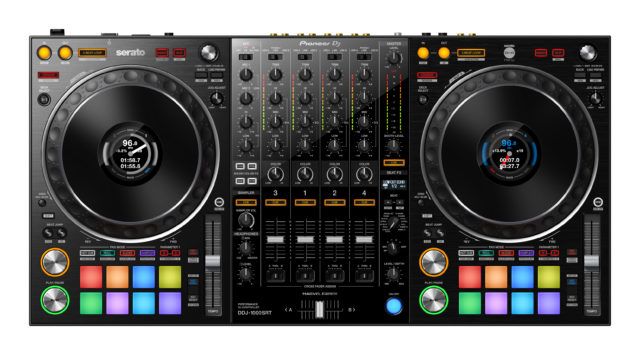
including full-size CDJ-style jog wheels with color displays.
Besides that, the DDJ-1000SRT also has in-wheel color displays, however, they don’t currently include as much detail as the DDJ-1000 did for Rekordbox DJ. The DDJ-1000SRT displays show the current BPM, the ± difference from the original BPM, the ±pitch range of the Tempo fader (which you can change straight from the hardware), track time elapsed, track time remaining, playback position, active deck indicator, and indicators for Vinyl and Slip modes (which you select via hardware buttons). It also shows the loop length when there is an active loop.
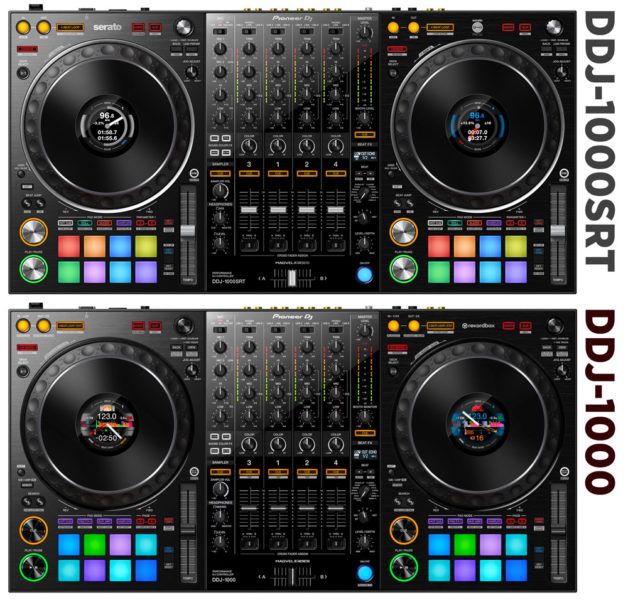
Unlike the DDJ-1000, the DDJ-1000SRT displays do not show the tracks’ waveform and their cue and loop points. Perhaps those could be added later in an update, because they are quite convenient on the DDJ-1000.
The closest Serato comparison to the new DDJ-1000SRT is probably Pioneer DJ’s DDJ-SX3 ($1,099), which has a full FX section at the top of each deck. However, the DDJ-1000SRT doesn’t really have any controls for Serato’s internal effects—even from the performance pads—so you’ll either have to rely on the hardware mixer’s effects or use a Serato-compatible accessory controller for the software’s effects.
The other small differences between the DDJ-1000 and DDJ-1000SRT—different pad modes, extra song key features, etc.—have to do with the differences between what Rekordbox and Serato offer.
Fully-functional Mixer
The DDJ-1000SRT’s excellent mixer works as a standalone unit when not hooked up to one of the two USB Type B ports on the back panel. Along with a professional array of in/out connections (listed above), the 24-bit/44.1kHz soundcard/mixer provides pristine, noise-free sound with plenty of output level from both the monitor and headphone outputs.

jacks (on the front panel).
Each of the four channel strips have switches for setting the channel to receive from either USB connection or from the phono/line input and another Cross Fader Assign switch for setting the channel to crossfader A, B, or Thru. All four channels as well as the Master have 18-LED green/orange/red level meters.
[the Magvel Fader Pro crossfader] boasts a durability claim of 10 million motions
The channels’ 3-band EQ knobs cut to -26dB each, rather than fully killing the band, but the Trim knobs can cut the output completely. Channel faders feel nice and smooth, but of course the Magvel crossfader—based on the Magvel Fader Pro from the DJM-S9 battle mixer—is the star of the show.
The crossfader boasts a durability claim of 10 million motions, and interacts seamlessly with the jog wheels for virtually latency-free response. To further refine the feel to your tastes, the jog wheels have Jog Adjust knobs that physically tighten or loosen the resistance of the jog wheel, so it’s easier or harder to turn.
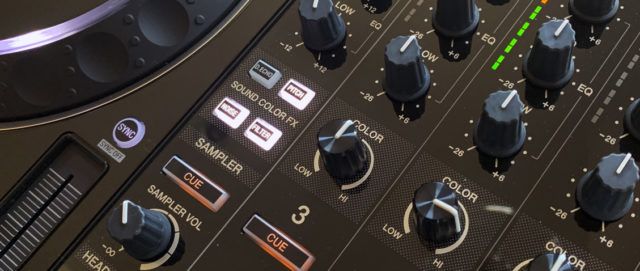
While the DDJ-1000SRT has no Serato FX controls, its great onboard effects almost make up for it. Four selectable Sound Color FX (two fewer than on the DJM-900NXS2)—Dub Echo, Pitch, Noise, and Filter—apply individually to the four mixer channels from the Color knob.
The Beat FX section is also scaled down from the DJM-900NXS2 mixer, but adds a lot. Its 14 tempo-synced effects can apply to the Master out, one of the four mixer channels, the Sampler or the Mic input. Beat value keys set the meter of the synced effects from 1/16 beat all the way up to 64 beats for certain effects like the flanger and phaser. I love that the mixer saves the sync value individually for each effect so that you can recall the last value easily. The tempo either auto-syncs to Serato’s incoming tempo, or you can set it by tapping.
Besides sounding fantastic, the Beat FX section adds two riser effects that aren’t on the DJM-900NXS2 mixer but are on the DDJ-1000: Mobius Saw and Mobius Tri. These effects apply an ascending or descending sawtooth or triangle synthesizer tone to the master output that syncs to ±1/16 to 64 beats.
Some last notable traits of the mixer include a dedicated Sampler Volume knob with Sampler headphone Cue toggle and a microphone Talk Over switch that ducks the music when you talk into the mic.
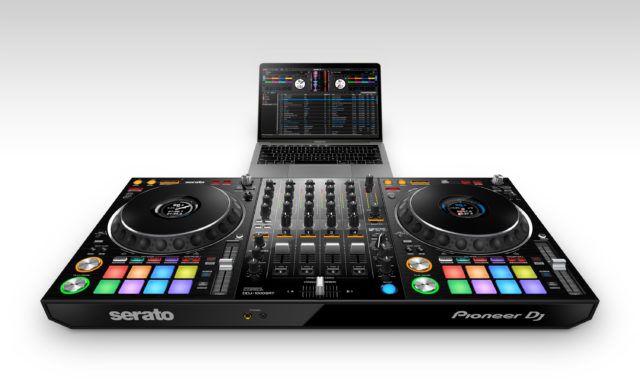
Real CDJ Feel
Like most Pioneer DJ controllers, the DDJ-1000SRT’s decks are not “mirror image,” but rather look the same from left to right.
The CDJ-style loop section at the top left of the deck includes set in/out points, increases/decreases loop length, or one-click sets a 4-beat loop. The Censor button is called Slip Reverse on the DDJ-1000; it reverses the audio in Slip mode for as long as you hold it down. Reverse (Shift-Censor) does a full reverse on the playback until you hit it again.
For browsing/loading tracks, the decks’ push-button encoder and two auxiliary buttons do a comprehensive job letting jump in and out of playlists/Crates, loading tracks, creating Instant Doubles, and scrolling through the view modes within Serato.
A few other differences from the DDJ-1000: The DDJ-1000SRT’s decks have a Grid button for using the jog wheels to adjust Serato’s beat grid when the software is in Smart Sync mode; the key controls section include Key Up and Key Down in addition to Key Lock, Key Sync, and Key Reset; and Beat Jump forward and backward buttons.
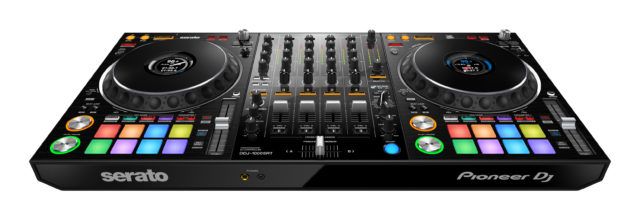
Pad Modes
Because of the software features, the DDJ-1000SRT’s pad modes differ quite a bit from the DDJ-1000. The Serato controller’s pads have Hot Cue, Cue Loop, Roll, Saved Loop, Slicer, Slicer Loop, Sampler, and Pitch Play, which launches a cue point with the audio pitched up or down depending on the pad.
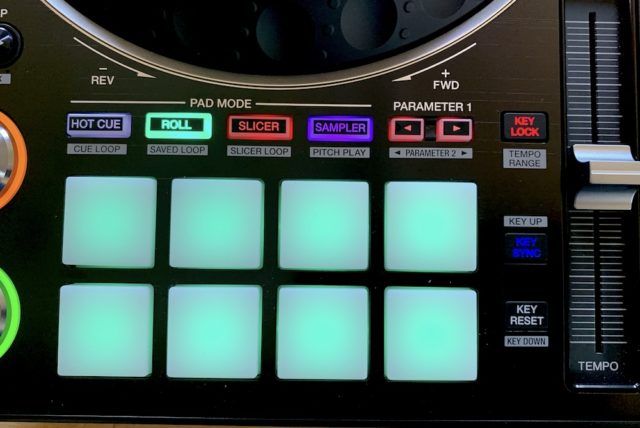
Powerful Parameter arrow keys modify the functions of some of the pad modes. With the Roll and Slicer modes, the Parameter keys increase or decrease beat repeat values of the pads; they change the root pitch for Pitch Play mode; and they scroll through the four sample banks in Sampler modes.
DDJ-One Rack
Given that the DDJ-1000 came out for Rekordbox DJ about a year ago, the DDJ-1000SRT for Serato doesn’t necessarily feel like groundbreaking news so much as it feels a welcome recognition that Pioneer DJ continues to address its high-end Serato users rather than forsaking them solely for Rekordbox DJ.
I’d like to see the DDJ-1000SRT’s displays add track waveforms with cue and loop points visible like the Rekordbox DJ version has, but I’m not sure if that’s possible. And if you really prefer to have dedicated controls for Serato’s internal effects rather than CDJ-style hardware, there are quite a few other comparable Serato controllers to consider.
Yet the bottom line is, the DDJ-1000SRT is the NXS2-style controller for Serato. And it’s a top-shelf Serato controller by any standard. It has a professional-level mixer; real CDJ jog wheels; large, super-responsive pads with a wide array of function modes; high-quality onboard effects; a full complement of audio connections; two USB ports; and nearly every hands-on function you’d need to keep focused on the controller rather than the mouse or keyboard. It’s compatible with all Serato expansions, and the company assured me that it will even work with Serato Studio music production software with the next update.

